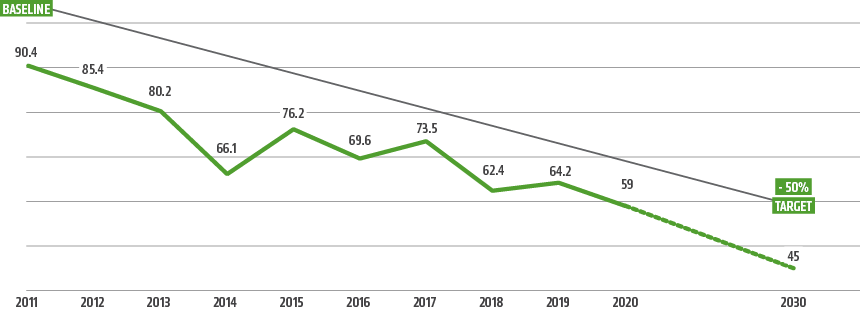Environmental Compliance
PGS operates around the globe in a range of environments, from the tropics to the arctic, from mature oil provinces to frontier areas. The countries in which we operate have varying requirements when it comes to environmental compliance and our business activities are exposed to different international, national, regional or state environmental laws and regulations.
We are committed to strict compliance with all environmental laws and regulations and have processes in place to assess our exposure to regulatory risk at the company level, for seismic projects and the locations where we have offices. Compliance obligations are identified, documented, and kept up to date in our Environmental Aspects and Compliance Obligations registers.
In 2020 we had one minor non-compliance with permit requirements on a geophysical survey. This has been reported to the relevant authority.
Biodiversity
Our ambition is to generate high-quality seismic data with the least amount of environmental impact and interference with other users of the oceans. Minimizing the acoustic impact of geophysical operations on marine life is a priority. We strictly comply with laws, regulations and industry best practices when conducting our work and continuously examine our methods to identify ways to further reduce our environmental footprint.
Our research and development teams are actively involved in various Research & Development projects that each may lead to measurable reductions in our environmental footprint and the acoustic impact of seismic surveys on marine life.
Marine-life Risk Assessments
Before every project, we ensure that the appropriate level of environment assessment has been conducted, conforming to national legal requirements related to the permitting or licensing of a seismic survey. Our project managers are responsible for ensuring that a marine-life monitoring and mitigation plan is in place in accordance with local legislation, best practices and client requirements. We assess risks relating to the interaction between vessel activities, marine life and other users of the oceans such as commercial and artisanal fishery and local indigenous populations.
A project-specific risk assessment is conducted, in addition to the national legal requirements for conducting environment impact or marine-life disturbance assessments as part of a project permitting or licensing process. Project risk assessment identifies relevant environment risks and appropriate mitigations for the specific geographic area of operation and is conducted throughout the lifecycle of a project, including those related to the potential interaction with marine life.
Marine-life Monitoring and Mitigation
PGS has global experience of implementing, monitoring and mitigating activities during seismic operations across the world. The marine life guidance procedures in our management system establish a common framework for the management of PGS activities offshore and potential interaction with marine wildlife.
All PGS vessels implement seismic source ‘soft-start’ measures as standard practice and, in the absence of national guidelines, we follow International Association of Geophysical Contractors (IAGC) recommended measures and guidance related to the interaction of underwater sound and marine life. We implement additional visual and acoustic monitoring and mitigation activities as identified by either regulatory, Environment Impact Assessment outcomes or client best practice requirements on a project-by-project basis. Such additional services are typically provided via third-party contractor personnel (Marine Mammal Observers, Protected Species Observers, Marine Fauna Observers and/or Passive Acoustic Monitoring). We have more personnel onboard responsible to monitoring and mitigating our effect on the environment than we have looking at the seismic data that we record.
In line with regulatory requirements, all sightings and detections of marine mammals during the survey period are recorded, including any beyond the maximum mitigation-zone boundaries. Examples of monitoring and mitigation measures that we implement include:
- Seismic survey planning to facilitate efficient seismic operations and minimize the risk to marine life.
- Realtime marine mammal visual and towed Passive Acoustic Monitoring during operations.
- Seismic source ‘soft-start’ procedures.
- Exclusion or safety zones.
- Delay to source start and suspension
of operations if marine mammals
are detected within pre-defined exclusion zones. - Stakeholder consultation where required in areas with potential for conflicting operations with other users of the oceans.
- Dedicated local Fishery Liaison Officer (FLO) to manage interaction and communication with fisheries.
Energy and Emissions
Reducing energy use and associated air emissions is a company-wide focus area for environmental performance. Our overall performance objective is to achieve continuous improvement towards our target of reducing relative emissions by 50% by 2030 compared to 2011.
All PGS vessels shall have a Ship Energy Efficiency Management Plan (SEEMP) in place, which establishes a mechanism to improve the energy efficiency of vessel operations. The SEEMP includes:
- Review and consideration of operational practices and technology upgrades that may contribute to optimizing the energy efficiency performance of a vessel.
- Implementation of monitoring tools and performance objectives related to improved energy efficiency and emission reduction.
Examples of energy reduction measures we have taken include:
- Engine and machinery upgrades
- Anti-barnacle technology to reduce drag from in-sea equipment.
- Installation of energy efficient air separation and free cooling technology for data centers
- Use of energy-efficient computer node technology
- Automatic light-control systems
